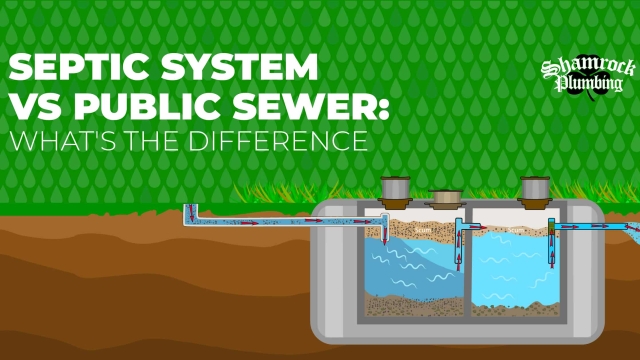
Pipe Dreams: Navigating the Depths of Plumbing and Septic Systems
Have you ever wondered about the intricate maze of pipes that lie beneath our homes and businesses, silently carrying water, waste, and dreams of a fully functioning plumbing system? Plumbing and septic systems are an essential but often overlooked part of our daily lives. When everything is running smoothly, we hardly give them a second thought. However, when a pipe bursts or the septic tank starts acting up, our cozy abodes can quickly turn into a nightmare.
Plumbing, with its network of pipes and fixtures, serves as the lifeline of any building, ensuring that water flows freely to where it’s needed most. From sinks and showers to toilets and washing machines, these systems provide us with the conveniences we often take for granted. And while simple in concept, plumbing can be a complex web of interconnected pipes, valves, and fittings, requiring careful planning and installation to guarantee its proper functioning.
On the other hand, septic systems are the unsung heroes responsible for managing the waste we produce. Instead of relying on municipal sewers, homes and establishments situated in more rural areas typically utilize septic systems. These underground structures may seem unassuming, but their role is vital in treating and disposing of wastewater. Employing a careful combination of biology and hydraulics, septic systems help break down organic matter, ensuring a safer and more environmentally-friendly end product.
Join us as we dive deep into the world of plumbing and septic systems, uncovering their inner workings, common issues, maintenance tips, and everything in between. Whether you’re a homeowner in need of guidance or simply curious about the inner workings of these indispensable systems, we’ll be your trusty guide as we navigate the twists and turns of the hidden infrastructure that keeps our lives running smoothly. It’s time to demystify the world beneath our feet and shine a light on the often unheralded work of plumbing and septic systems.
The Basics of Plumbing Systems
Plumbing systems play a crucial role in our daily lives, ensuring the smooth flow of water and waste throughout our homes. Whether you’re taking a refreshing shower or washing dishes after a family meal, plumbing systems make it all possible. In this article, we will delve into the intricacies of plumbing and septic systems to understand the importance of this often-underappreciated aspect of our homes.
The foundation of any plumbing system lies in its network of pipes. These pipes are responsible for carrying water to various fixtures, such as sinks, showers, and toilets, allowing us to access water whenever we need it. Additionally, they also carry the waste and wastewater away from our homes, ensuring proper sanitation and cleanliness. Without a well-designed and maintained plumbing system, our daily routines would be far more challenging.
To ensure the efficient and reliable operation of plumbing systems, it’s essential to consider the materials used in the construction of pipes. Common types of pipes include copper, PVC (polyvinyl chloride), and PEX (cross-linked polyethylene). Each material has its advantages and is suitable for specific applications. For example, copper pipes are known for their durability and resistance to corrosion, while PVC pipes are cost-effective and commonly used in drain and vent systems.
Moreover, plumbing systems often integrate septic tanks to manage wastewater. These underground tanks play a vital role in treating and disposing of wastewater from our homes in areas where public sewer systems are not available. Septic systems use a combination of natural processes and bacteria to break down solids, allowing liquids to safely drain into the surrounding soil. Regular maintenance and proper usage are critical to keeping septic systems functioning effectively.
In the following sections, we will explore different aspects of plumbing and septic systems, including common issues, maintenance tips, and eco-friendly solutions. By gaining a deeper understanding of these essential components, we can ensure the smooth functioning of our plumbing systems and contribute to a healthier, more sustainable environment.
Understanding Septic Systems
- What are Septic Systems?

Septic Systems are self-contained wastewater treatment systems used in homes and buildings that are not connected to a centralized sewer system. They are an essential part of rural and suburban areas where connecting to a municipal sewer network is not feasible. These systems provide a practical solution for treating and disposing of household wastewater, including sewage and other organic waste.
- How do Septic Systems Work?
A typical septic system consists of three main components: the septic tank, the drainfield (also known as the leachfield or absorption field), and the soil beneath. When wastewater flows from the household plumbing fixtures, it enters the septic tank for initial treatment. The septic tank is a watertight container made of concrete, fiberglass, or plastic, designed to separate solids and liquids. Here, bacteria and other microorganisms break down solid waste, converting it into gases, liquids, and a residue called sludge.
- Maintenance and Care for Septic Systems
Regular maintenance and proper care are crucial to ensure the longevity and optimal functioning of septic systems. Here are a few important guidelines to keep in mind:
Regular pumping: The accumulation of sludge in the septic tank over time can lead to system failure. It is recommended to have the tank pumped out every three to five years, depending on its size and usage.
Water conservation: Excessive water usage can overload the septic system and disrupt its effectiveness. Conserving water through the use of efficient plumbing fixtures and being mindful of water consumption habits can help prevent unnecessary strain on the system.
Proper waste disposal: Only biodegradable and septic-safe materials should be flushed down the drains. Avoid flushing non-biodegradable items, chemicals, oils, and excessive amounts of household cleaners, as they can disrupt the balance of the septic system’s microbial activity.
Understanding the basics of septic systems and implementing proper care practices is essential for homeowners and property owners relying on these systems to efficiently manage wastewater. By following these guidelines, you can minimize the risk of potential issues and ensure the smooth operation of your septic system for years to come.
Maintaining and Troubleshooting Plumbing and Septic Systems
In order to ensure the smooth operation of your plumbing and septic systems, regular maintenance and troubleshooting are essential. Here are some important tips to help you navigate the depths of these crucial systems.
Regular inspection and cleaning: It’s important to regularly inspect and clean your plumbing and septic systems to prevent blockages and potential problems. For your plumbing system, check for leaks, corrosion, and any signs of wear and tear. Additionally, clean your drains and pipes periodically to remove any buildup of debris or mineral deposits.
Watch what goes down the drain: Being mindful about what you put down the drain can go a long way in preventing plumbing and septic issues. Avoid disposing of grease, oil, or large food particles down the kitchen sink, as they can cause clogs. Similarly, limit the amount of non-biodegradable items and chemicals that you flush down the toilet, as they can harm the septic system.
Regular septic tank maintenance: If you have a septic system, it’s crucial to have your septic tank pumped regularly. This will help prevent solids from building up and causing blockages or backups. It’s recommended to have a professional inspect and pump your septic tank every three to five years, depending on its size and usage.
Plumbing Repair
Remember, proper maintenance and troubleshooting can prolong the lifespan of your plumbing and septic systems, as well as prevent costly repairs. By following these simple guidelines, you can ensure a well-functioning and reliable system for years to come.

